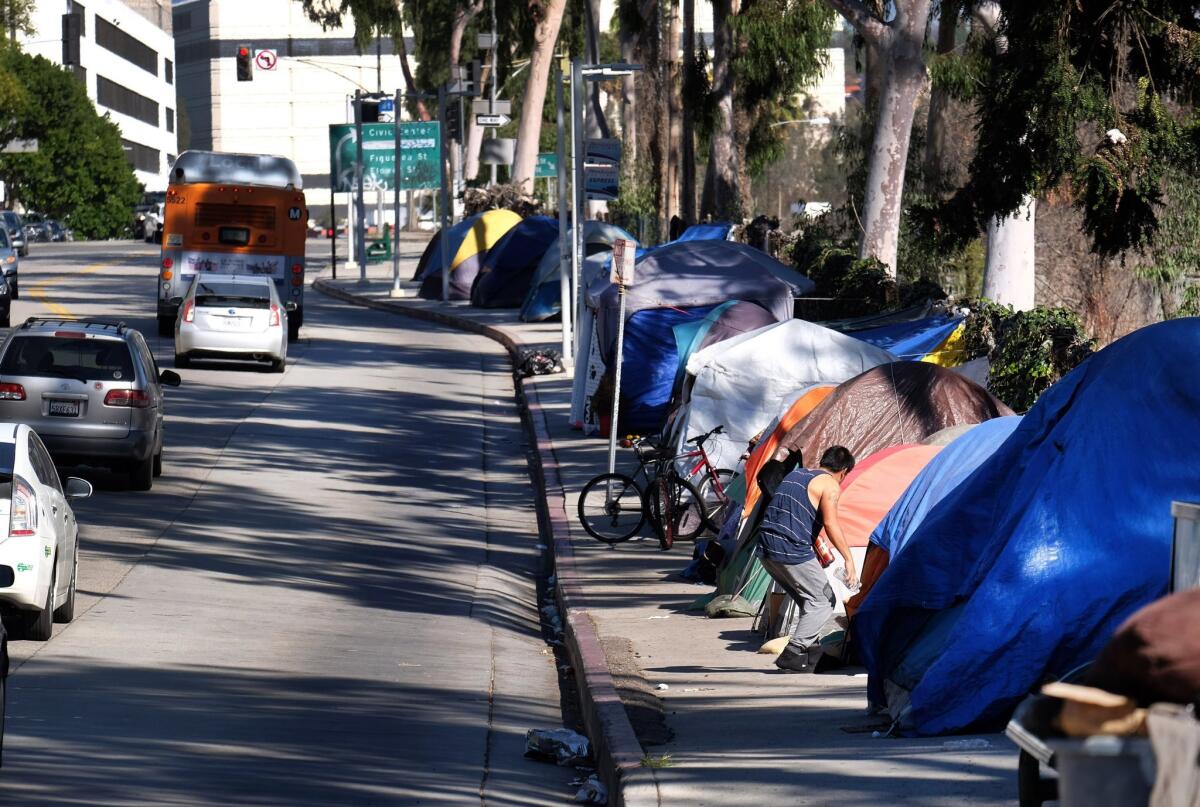Editorial: L.A. might ban the homeless from sleeping near schools or parks. Then where will they go?

For more than a decade, the city of Los Angeles has been required by a court settlement to let homeless people sleep overnight on the sidewalks because it cannot supply enough housing for them. The 9th Circuit Court of Appeals underlined that point last year in a case involving the city of Boise, Idaho, declaring that prosecuting homeless people for sleeping on public property when there was no available shelter was cruel and unusual punishment.
In a footnote to the ruling, however, the court also said that cities might be able to set some restrictions on when, where and how people slept outside. Seizing on that caveat, the City Council Committee on Homelessness and Poverty proposed to make certain areas of the city essentially off-limits to homeless individuals. Although the committee’s chairman, Councilman Mitch O’Farrell, presented the proposed revision of the city’s loitering ordinance as an attempt to comply with the Boise decision and balance the needs of the homeless with public safety, it would impose a host of new restrictions that could make it much more difficult for homeless people to find places to sleep.
Under the proposed revisions, a person could not sit, lie or sleep within 500 feet of a park, school or daycare center. Also barred would be underpasses and bridges that the council designates as a school route; crowded public sidewalks near large venues; and bike paths. Homeless people would be prohibited from sitting or lying near any of the following facilities if they opened after Jan. 1, 2018: shelters, storage facilities, homeless service centers and “safe parking” lots for people who sleep in their vehicles. Also, there would be no sitting or lying within 10 feet of a driveway or entrance.
It’s not outrageous for the city to want to set reasonable rules that balance the rights of the homeless with the need to keep L.A. clean, livable and appealing to other residents. It’s reasonable to expect homeless encampments not to block entire sidewalks or entrances. This page supported the city’s decision to ban sleeping on the street in areas where new shelters had been built to accommodate the homeless people in the neighborhood.
But this proposal would make it impermissible for homeless people to sleep in swaths of the city, and it would almost certainly cause mass confusion over where homeless people could sleep. How would a homeless person even know if he or she were 500 feet from a daycare center or on a school route? And how can the city pass a prohibition on resting 500 feet from a park when public parks are open to everyone? Could you sit or lie in the park but not outside the park? And would all of this be enforced around the clock? City officials don’t know yet.
The city could make it so difficult to find a place to sleep or sit that it could end up doing the very thing that the 9th Circuit said a city cannot do: criminalize being homeless. Carol Sobel, an attorney and advocate for homeless people, estimated that by the time you measure 500 feet from various parks and daycare centers, a third of the Skid Row neighborhood could be off-limits under the restrictions.
What the proposal will not do is make homeless people magically disappear. People will either stay where they’ve been camping in violation of the new laws and risk getting cited by police, or move on — often to streets that don’t have parks, schools or daycare centers nearby. With the long-promised housing the city is supposed to be building for the homeless still waiting to be completed, they have nowhere else to go.
These restrictions imply that homeless people are so dangerous that they can’t be anywhere near a school or a daycare center. But that contradicts the message city leaders have been sending at public meetings, where they try to persuade communities to accept supportive housing developments and shelters by sharing stories of long-suffering homeless people who thrived once they got into housing. Council members know that while there are, no doubt, dangerous people among the homeless, the vast majority are not mentally ill or substance-addicted or violent criminals. Demonizing them doesn’t help anybody.
Of course, no one should have to walk down city sidewalks strewn with trash and stained with human feces. No one should have to live on those sidewalks, either. If officials want to make the city more livable for the homeless and non-homeless alike, they should put out trash receptacles for homeless people to use and offer more access to toilets and mobile showers. And, ultimately, the city must have more supportive housing and more shelters.
The City Council, which is expected to discuss the restrictions soon, has struggled for years to strike the right balance between the needs of homeless people and the rights of the city’s residents and businesses. We get it — Angelenos are tired of this crisis and are eager to see some progress. This proposal, however, isn’t the answer.
More to Read
A cure for the common opinion
Get thought-provoking perspectives with our weekly newsletter.
You may occasionally receive promotional content from the Los Angeles Times.










